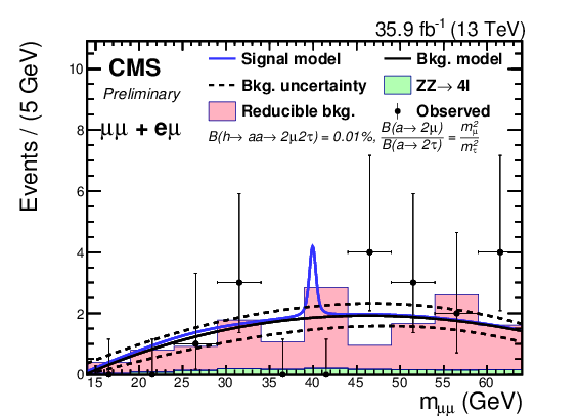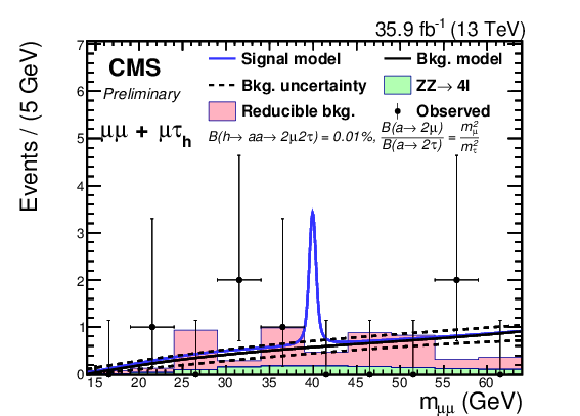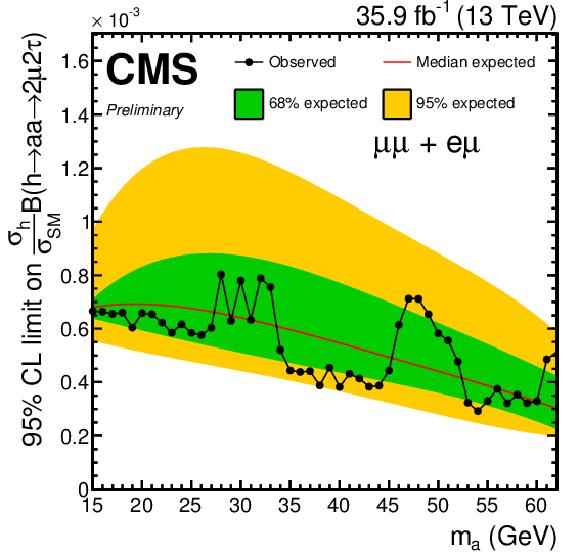

Compact Muon Solenoid
LHC, CERN
| CMS-PAS-HIG-17-029 | ||
| Search for the exotic decay of the Higgs boson to a pair of light pseudoscalars in the final state of two muons and two τ leptons at √s= 13 TeV | ||
| CMS Collaboration | ||
| March 2018 | ||
| Abstract: A search for exotic Higgs boson decays to light pseudoscalars in the final state of two muons and two τ leptons is performed using 35.9 fb−1 of data accumulated by the CMS experiment at the LHC at a center-of-mass energy of 13 TeV. Masses of the pseudoscalar boson between 15 and 62.5 GeV are probed, and no significant excess of data is observed above the prediction of the standard model. Upper limits are set on the branching fraction of the Higgs boson to two light pseudoscalar bosons in different types of two-Higgs-doublet models extended with a complex scalar singlet. | ||
|
Links:
CDS record (PDF) ;
inSPIRE record ;
CADI line (restricted) ;
These preliminary results are superseded in this paper, JHEP 11 (2018) 018. The superseded preliminary plots can be found here. |
||
| Figures | |

png pdf |
Figure 1:
Parameterized dimuon invariant mass distributions of the h→aa→2μ2τ (left) and h→aa→4τ (right) signal processes simulated at different ma values in the μμ+μτh final state. The normalization corresponds to the number of expected signal events after the selection, assuming the production cross section of the Higgs boson predicted in the SM, B(h→aa→2μ2τ)=0.1, and the relation in Eq.(1) to scale the h→aa→4τ contribution. |

png pdf |
Figure 1-a:
Parameterized dimuon invariant mass distributions of the h→aa→2μ2τ (left) and h→aa→4τ (right) signal processes simulated at different ma values in the μμ+μτh final state. The normalization corresponds to the number of expected signal events after the selection, assuming the production cross section of the Higgs boson predicted in the SM, B(h→aa→2μ2τ)=0.1, and the relation in Eq.(1) to scale the h→aa→4τ contribution. |

png pdf |
Figure 1-b:
Parameterized dimuon invariant mass distributions of the h→aa→2μ2τ (left) and h→aa→4τ (right) signal processes simulated at different ma values in the μμ+μτh final state. The normalization corresponds to the number of expected signal events after the selection, assuming the production cross section of the Higgs boson predicted in the SM, B(h→aa→2μ2τ)=0.1, and the relation in Eq.(1) to scale the h→aa→4τ contribution. |

png pdf |
Figure 2:
Parameterization of the reducible (left) and irreducible (right) backgrounds in the μμ+μτh final state. The points for the irreducible background represent events selected in simulation, whereas they correspond to observed data events in the same-sign region with relaxed isolation for the reducible background. |

png pdf |
Figure 2-a:
Parameterization of the reducible (left) and irreducible (right) backgrounds in the μμ+μτh final state. The points for the irreducible background represent events selected in simulation, whereas they correspond to observed data events in the same-sign region with relaxed isolation for the reducible background. |

png pdf |
Figure 2-b:
Parameterization of the reducible (left) and irreducible (right) backgrounds in the μμ+μτh final state. The points for the irreducible background represent events selected in simulation, whereas they correspond to observed data events in the same-sign region with relaxed isolation for the reducible background. |

png pdf |
Figure 3:
Dimuon mass distributions in the μμ+eμ (top left), μμ+eτh (top right), μμ+μτh (bottom left), and μμ+τhτh (bottom right) final states. The total background estimation and its uncertainty are given by the black lines. The histograms for the two background components are shown for illustrative purposes only as the background models are extracted from unbinned fits. The signal model is drawn in blue above the background model: it includes both h→aa→2μ2τ and h→aa→4τ, and is normalized using B(h→aa→2μ2τ)=0.01, assuming the relation in Eq.(1) to determine the relative proportion of these processes. The production cross section of the Higgs boson predicted in the SM is assumed. |

png pdf |
Figure 3-a:
Dimuon mass distributions in the μμ+eμ (top left), μμ+eτh (top right), μμ+μτh (bottom left), and μμ+τhτh (bottom right) final states. The total background estimation and its uncertainty are given by the black lines. The histograms for the two background components are shown for illustrative purposes only as the background models are extracted from unbinned fits. The signal model is drawn in blue above the background model: it includes both h→aa→2μ2τ and h→aa→4τ, and is normalized using B(h→aa→2μ2τ)=0.01, assuming the relation in Eq.(1) to determine the relative proportion of these processes. The production cross section of the Higgs boson predicted in the SM is assumed. |

png pdf |
Figure 3-b:
Dimuon mass distributions in the μμ+eμ (top left), μμ+eτh (top right), μμ+μτh (bottom left), and μμ+τhτh (bottom right) final states. The total background estimation and its uncertainty are given by the black lines. The histograms for the two background components are shown for illustrative purposes only as the background models are extracted from unbinned fits. The signal model is drawn in blue above the background model: it includes both h→aa→2μ2τ and h→aa→4τ, and is normalized using B(h→aa→2μ2τ)=0.01, assuming the relation in Eq.(1) to determine the relative proportion of these processes. The production cross section of the Higgs boson predicted in the SM is assumed. |

png pdf |
Figure 3-c:
Dimuon mass distributions in the μμ+eμ (top left), μμ+eτh (top right), μμ+μτh (bottom left), and μμ+τhτh (bottom right) final states. The total background estimation and its uncertainty are given by the black lines. The histograms for the two background components are shown for illustrative purposes only as the background models are extracted from unbinned fits. The signal model is drawn in blue above the background model: it includes both h→aa→2μ2τ and h→aa→4τ, and is normalized using B(h→aa→2μ2τ)=0.01, assuming the relation in Eq.(1) to determine the relative proportion of these processes. The production cross section of the Higgs boson predicted in the SM is assumed. |

png pdf |
Figure 3-d:
Dimuon mass distributions in the μμ+eμ (top left), μμ+eτh (top right), μμ+μτh (bottom left), and μμ+τhτh (bottom right) final states. The total background estimation and its uncertainty are given by the black lines. The histograms for the two background components are shown for illustrative purposes only as the background models are extracted from unbinned fits. The signal model is drawn in blue above the background model: it includes both h→aa→2μ2τ and h→aa→4τ, and is normalized using B(h→aa→2μ2τ)=0.01, assuming the relation in Eq.(1) to determine the relative proportion of these processes. The production cross section of the Higgs boson predicted in the SM is assumed. |

png pdf |
Figure 4:
Upper limits at 95% CL on (σh/σSM)×B(h→aa→2μ2τ), in the μμ+eμ (top left), μμ+eτh (top right), μμ+μτh (center left), μμ+τhτh (center right) final states, and for the combination of these final states (bottom). The h→aa→4τ process is considered as a part of the signal, and is scaled with respect to the h→aa→2μ2τ signal using Eq.(1). |

png pdf |
Figure 4-a:
Upper limits at 95% CL on (σh/σSM)×B(h→aa→2μ2τ), in the μμ+eμ (top left), μμ+eτh (top right), μμ+μτh (center left), μμ+τhτh (center right) final states, and for the combination of these final states (bottom). The h→aa→4τ process is considered as a part of the signal, and is scaled with respect to the h→aa→2μ2τ signal using Eq.(1). |

png pdf |
Figure 4-b:
Upper limits at 95% CL on (σh/σSM)×B(h→aa→2μ2τ), in the μμ+eμ (top left), μμ+eτh (top right), μμ+μτh (center left), μμ+τhτh (center right) final states, and for the combination of these final states (bottom). The h→aa→4τ process is considered as a part of the signal, and is scaled with respect to the h→aa→2μ2τ signal using Eq.(1). |

png pdf |
Figure 4-c:
Upper limits at 95% CL on (σh/σSM)×B(h→aa→2μ2τ), in the μμ+eμ (top left), μμ+eτh (top right), μμ+μτh (center left), μμ+τhτh (center right) final states, and for the combination of these final states (bottom). The h→aa→4τ process is considered as a part of the signal, and is scaled with respect to the h→aa→2μ2τ signal using Eq.(1). |

png pdf |
Figure 4-d:
Upper limits at 95% CL on (σh/σSM)×B(h→aa→2μ2τ), in the μμ+eμ (top left), μμ+eτh (top right), μμ+μτh (center left), μμ+τhτh (center right) final states, and for the combination of these final states (bottom). The h→aa→4τ process is considered as a part of the signal, and is scaled with respect to the h→aa→2μ2τ signal using Eq.(1). |

png pdf |
Figure 4-e:
Upper limits at 95% CL on (σh/σSM)×B(h→aa→2μ2τ), in the μμ+eμ (top left), μμ+eτh (top right), μμ+μτh (center left), μμ+τhτh (center right) final states, and for the combination of these final states (bottom). The h→aa→4τ process is considered as a part of the signal, and is scaled with respect to the h→aa→2μ2τ signal using Eq.(1). |

png pdf |
Figure 5:
Observed limits on (σh/σSM)×B(h→aa) in 2HDM+S type III (left) and type IV (right). The number 34% corresponds to the limit on the branching fraction of the Higgs boson to BSM particles at the 95% CL obtained with data collected at a center-of-mass energy of 8 TeV by the CMS and ATLAS experiments [10]. |

png pdf |
Figure 5-a:
Observed limits on (σh/σSM)×B(h→aa) in 2HDM+S type III (left) and type IV (right). The number 34% corresponds to the limit on the branching fraction of the Higgs boson to BSM particles at the 95% CL obtained with data collected at a center-of-mass energy of 8 TeV by the CMS and ATLAS experiments [10]. |

png pdf |
Figure 5-b:
Observed limits on (σh/σSM)×B(h→aa) in 2HDM+S type III (left) and type IV (right). The number 34% corresponds to the limit on the branching fraction of the Higgs boson to BSM particles at the 95% CL obtained with data collected at a center-of-mass energy of 8 TeV by the CMS and ATLAS experiments [10]. |

png pdf |
Figure 6:
Expected and observed 95% CL limits on σhσSMB(h→aa) in 2HDM+S type III for tanβ=5. The branching fractions of the pseudoscalar boson to SM particles are computed following a model described in Ref. [13]. Grey shaded regions correspond to regions where theoretical predictions for the branching fractions of the pseudoscalar boson to SM particles are not reliable. The result described in this analysis corresponds to the light blue curves. Results in the bbττ channel were obtained at a center-of-mass energy of 13 TeV [48], while other results were obtained at 8 TeV center-of-mass energy [14]. |
| Tables | |

png pdf |
Table 1:
Yields of the signal and background processes in the four final states, as well as the number of observed events in each final state. The signal yields are given for B(h→aa→2μ2τ)=0.01. The h→aa→4τ signal is scaled assuming couplings of the pseudoscalar boson proportional to the squared lepton mass, as in Eq.(1). The uncertainties come from statistical and systematic sources. |
| Summary |
| A search for the exotic decay of the Higgs boson to a pair of light pseudoscalars in the final state of two muons and two τ leptons has been performed using data collected by the CMS experiment in 2016 at a center-of-mass energy of 13 TeV. The results are extracted from an unbinned fit of the dimuon mass spectrum. Limits are set at the 95% confidence level on the branching fraction B(h→aa→2μ2τ) for masses of the light pseudoscalar between 15 and 62.5 GeV, and are as low as 1.2×10−4 for a mass of 60 GeV. These are the most stringent limits obtained in the final state of two muons and two τ leptons for masses above 15 GeV by more than a factor two, and provide the tightest constraints so far in this mass range on exotic Higgs boson decays in some scenarios where decays of the pseudoscalars to leptons are enhanced. |
| References | ||||
| 1 | F. Englert and R. Brout | Broken symmetry and the mass of gauge vector mesons | PRL 13 (1964) 321 | |
| 2 | P. W. Higgs | Broken symmetries, massless particles and gauge fields | PL12 (1964) 132 | |
| 3 | P. W. Higgs | Broken symmetries and the masses of gauge bosons | PRL 13 (1964) 508 | |
| 4 | G. S. Guralnik, C. R. Hagen, and T. W. B. Kibble | Global conservation laws and massless particles | PRL 13 (1964) 585 | |
| 5 | P. W. Higgs | Spontaneous symmetry breakdown without massless bosons | PR145 (1966) 1156 | |
| 6 | T. W. B. Kibble | Symmetry Breaking in Non-Abelian Gauge Theories | PR155 (1967) 1554 | |
| 7 | ATLAS Collaboration | Observation of a new particle in the search for the Standard Model Higgs boson with the ATLAS detector at the LHC | PLB 716 (2012) | 1207.7214 |
| 8 | CMS Collaboration | Observation of a new boson at a mass of 125 GeV with the CMS experiment at the LHC | PLB 716 (2012) | CMS-HIG-12-028 1207.7235 |
| 9 | CMS Collaboration | Observation of a new boson with mass near 125 gev in pp collisions at √s= 7 and 8 tev | JHEP 06 (2013) 081 | |
| 10 | ATLAS and CMS Collaborations | Measurements of the Higgs boson production and decay rates and constraints on its couplings from a combined ATLAS and CMS analysis of the LHC pp collision data at √s= 7 and 8 TeV | JHEP 08 (2016) 045 | 1606.02266 |
| 11 | ATLAS and CMS Collaborations | Combined measurement of the Higgs boson mass in pp collisions at √s= 7 and 8 TeV with the ATLAS and CMS experiments | PRL 114 (2015) 191803 | 1503.07589 |
| 12 | CMS Collaboration | Searches for invisible decays of the Higgs boson in pp collisions at √s= 7, 8, and 13 TeV | JHEP 02 (2017) 135 | CMS-HIG-16-016 1610.09218 |
| 13 | D. Curtin et al. | Exotic decays of the 125 GeV Higgs boson | PRD 90 (2014) 075004 | 1312.4992 |
| 14 | CMS Collaboration | Search for light bosons in decays of the 125 GeV Higgs boson in proton-proton collisions at √s= 8 TeV | JHEP 10 (2017) 076 | CMS-HIG-16-015 1701.02032 |
| 15 | CMS Collaboration | Search for a very light NMSSM Higgs boson produced in decays of the 125 GeV scalar boson and decaying into τ leptons in pp collisions at √s= 8 TeV | JHEP 01 (2016) 079 | CMS-HIG-14-019 1510.06534 |
| 16 | CMS Collaboration | A search for pair production of new light bosons decaying into muons | PLB 752 (2016) 146 | CMS-HIG-13-010 1506.00424 |
| 17 | ATLAS Collaboration | Search for the Higgs boson produced in association with a W boson and decaying to four b-quarks via two spin-zero particles in pp collisions at 13 TeV with the ATLAS detector | EPJC 76 (2016) 605 | 1606.08391 |
| 18 | ATLAS Collaboration | Search for new light gauge bosons in Higgs boson decays to four-lepton final states in pp collisions at √s= 8 TeV with the ATLAS detector at the LHC | PRD 92 (2015) 092001 | 1505.07645 |
| 19 | ATLAS Collaboration | Search for new phenomena in events with at least three photons collected in pp collisions at √s= 8 TeV with the ATLAS detector | EPJC 76 (2016) 210 | 1509.05051 |
| 20 | ATLAS Collaboration | Search for Higgs bosons decaying to aa in the μμττ final state in pp collisions at √s= 8 TeV with the ATLAS experiment | PRD 92 (2015) 052002 | 1505.01609 |
| 21 | CMS Collaboration | The CMS trigger system | JINST 12 (2017) P01020 | CMS-TRG-12-001 1609.02366 |
| 22 | CMS Collaboration | The CMS experiment at the CERN LHC | JINST 3 (2008) S08004 | CMS-00-001 |
| 23 | J. Alwall et al. | The automated computation of tree-level and next-to-leading order differential cross sections, and their matching to parton shower simulations | JHEP 07 (2014) 079 | 1405.0301 |
| 24 | J. Alwall et al. | Comparative study of various algorithms for the merging of parton showers and matrix elements in hadronic collisions | EPJC 53 (2008) 473 | 0706.2569 |
| 25 | T. Sjostrand et al. | An introduction to PYTHIA 8.2 | CPC 191 (2015) 159 | 1410.3012 |
| 26 | CMS Collaboration | Event generator tunes obtained from underlying event and multiparton scattering measurements | EPJC 76 (2016) 155 | CMS-GEN-14-001 1512.00815 |
| 27 | S. Alioli, P. Nason, C. Oleari, and E. Re | NLO vector-boson production matched with shower in POWHEG | JHEP 07 (2008) 060 | 0805.4802 |
| 28 | P. Nason | A New method for combining NLO QCD with shower Monte Carlo algorithms | JHEP 11 (2004) 040 | hep-ph/0409146 |
| 29 | S. Frixione, P. Nason, and C. Oleari | Matching NLO QCD computations with parton shower simulations: the POWHEG method | JHEP 11 (2007) 070 | 0709.2092 |

|
Compact Muon Solenoid LHC, CERN |

|

|

|

|

|

|